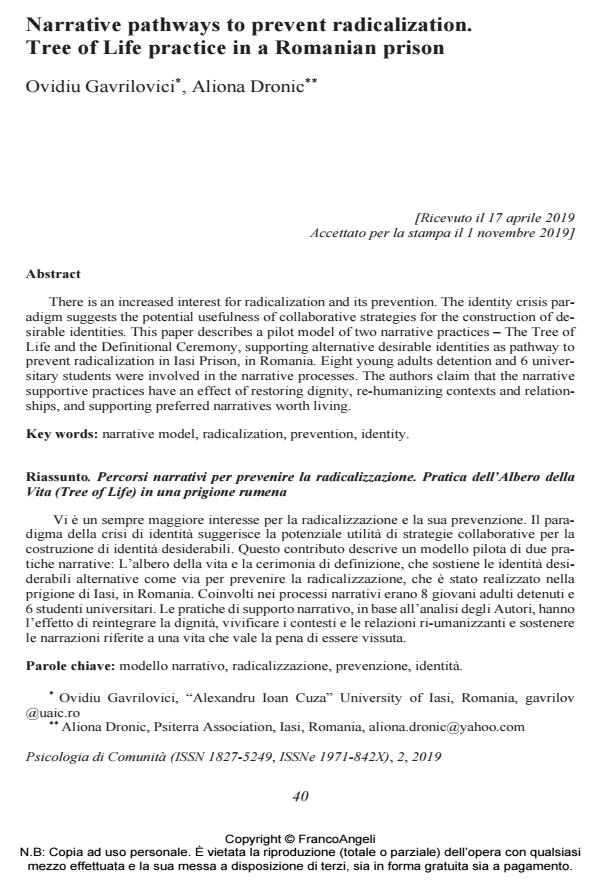Narrative pathways to prevent radicalization. Tree of Life practice in a Romanian prison
Titolo Rivista PSICOLOGIA DI COMUNITA’
Autori/Curatori Ovidiu Gavrilovici, Aliona Dronic
Anno di pubblicazione 2020 Fascicolo 2019/2
Lingua Inglese Numero pagine 16 P. 40-55 Dimensione file 214 KB
DOI 10.3280/PSC2019-002004
Il DOI è il codice a barre della proprietà intellettuale: per saperne di più
clicca qui
Qui sotto puoi vedere in anteprima la prima pagina di questo articolo.
Se questo articolo ti interessa, lo puoi acquistare (e scaricare in formato pdf) seguendo le facili indicazioni per acquistare il download credit. Acquista Download Credits per scaricare questo Articolo in formato PDF

FrancoAngeli è membro della Publishers International Linking Association, Inc (PILA)associazione indipendente e non profit per facilitare (attraverso i servizi tecnologici implementati da CrossRef.org) l’accesso degli studiosi ai contenuti digitali nelle pubblicazioni professionali e scientifiche
There is an increased interest for radicalization and its prevention. The identity crisis para-digm suggests the potential usefulness of collaborative strategies for the construction of desir-able identities. This paper describes a pilot model of two narrative practices - The Tree of Life and the Definitional Ceremony, supporting alternative desirable identities as pathway to pre-vent radicalization in Iasi Prison, in Romania. Eight young adults detention and 6 universitary students were involved in the narrative processes. The authors claim that the narrative support-ive practices have an effect of restoring dignity, re-humanizing contexts and relationships, and supporting preferred narratives worth living.
Vi è un sempre maggiore interesse per la radicalizzazione e la sua prevenzione. Il paradigma della crisi di identità suggerisce la potenziale utilità di strategie collaborative per la costruzione di identità desiderabili. Questo contributo descrive un modello pilota di due pratiche narrative: L’albero della vita e la cerimonia di definizione, che sostiene le identità desiderabili alternative come via per prevenire la radicalizzazione, che è stato realizzato nella prigione di Iasi, in Ro-mania. Coinvolti nei processi narrativi erano 8 giovani adulti detenuti e 6 studenti universitari. Le pratiche di supporto narrativo, in base all’analisi degli Autori, hanno l’effetto di reintegrare la dignità, vivificare i contesti e le relazioni ri-umanizzanti e sostenere le narrazioni riferite a una vita che vale la pena di essere vissuta.
Parole chiave:Modello narrativo, radicalizzazione, prevenzione, identità.
- Preventing Violent Radicalisation in Europe Ovidiu Gavrilovici, Aliona Dronic, Laura Remaschi, pp.59 (ISBN:978-3-030-52047-2)
Ovidiu Gavrilovici, Aliona Dronic, Narrative pathways to prevent radicalization. Tree of Life practice in a Romanian prison in "PSICOLOGIA DI COMUNITA’" 2/2019, pp 40-55, DOI: 10.3280/PSC2019-002004